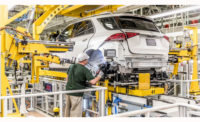Adhesive Bonding System Improves Sunroof Assembly at Mercedes-Benz

Mercedes-Benz offers the panoramic sunroof as an option on its GL luxury SUV. Photo courtesy Mercedes-Benz

Freeglass GmbH & Co. KG uses an RV130 six-axis robot to attach the frames of roller blinds to sunroofs. Graphic courtesy Reis Robotics


As motorists look to enhance their driving experience, sunroofs are growing in popularity and variety. One of the newer types is the panoramic sunroof, which provides openings above both the front and rear seats.
Schwaikheim, Germany-based Freeglass GmbH & Co. KG has been a leading manufacturer of panoramic sunroofs since 2001. One of the company’s main customers is Mercedes-Benz, which offers the panoramic sunroof as an option on its GL luxury SUV.
Freeglass’ sunroof consists of a transparent center and nontransparent border that are injection molded in one simple operation. The transparent center is made of durable polycarbonate with a tinted scratch-proof coating. It meets all glass standards. An invisible antenna is also integrated in the sunroof.
In 2012, Mercedes began offering a roller blind with the sunroof so motorists can shade themselves from the sun in hot weather. Attaching the frame of the blind to the sunroof was a challenge, admits Jens Kirchhoff, strategic purchaser for Freeglass.
The company tried manual fixation of the frame, but it proved unreliable. So Freeglass worked with Reis Robotics for four months to develop an automated system that ensures proper positioning, holding and gluing of the frame. Most importantly, it integrates easily with the sunroof production line.
Prior to installation, the frame is cleaned and one side is treated with an adhesion-enhancing primer. Special end-of-arm-tooling enables an RV130 six-axis robot to pick up the frame, rotate it so the treated side points upward, and place the treated side beneath a nozzle that dispenses a triangular bead of glue.
The robot moves the frame toward a nearby vertical conveyor featuring several goods carriers, each of which holds a sunroof. When the conveyor stops, the robot docks to a goods carrier. Clamps immediately secure the frame to a sunroof to ensure accurate positioning, and the robot undocks to retrieve the next frame.
After this, the sunroof is conveyed for six minutes so the glue dries completely. It is then removed from the conveyor and transported to other workstations for further processing.
Kirchhoff points out that the robot’s controller continuously synchronizes robotic movements with glue dispensing to optimize production and prevent glue from being wasted. Nozzle orientation is adjustable to ensure consistent bead thickness and ease maintenance. Before each new gluing operation, a special mechanism removes glue remnants from the nozzle.
The RV130 series encompasses four robots. Model RV130-40 handles payloads up to 40 kilograms, and it has a maximum reach of 3,100 millimeters. The RV130-60 moves 60-kilogram payloads up to 2,800 millimeters.
Larger models include the RV130-90 and -130, with capacities of 90 and 130 kilograms, respectively. Maximum reach is 3,000 millimeters for the RV130-90, and 2,650 millimeters for the RV130-130.
For more information on assembly robots, call 847-741-9500 or visit www.reisroboticsusa.com.
Looking for a reprint of this article?
From high-res PDFs to custom plaques, order your copy today!







